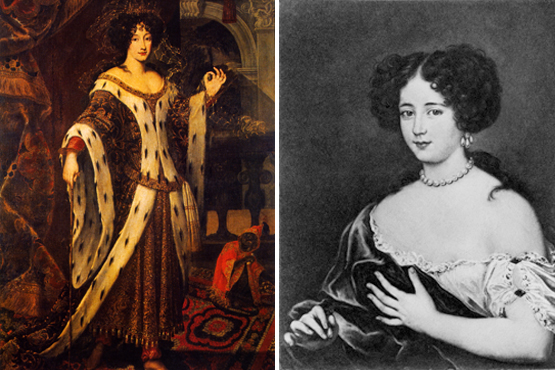Women of the Road
Following the 17th century’s Thelma and Louise

It sounds like the plot of a novel: two sisters in 17th-century Europe, trapped in unhappy marriages — one to a Roman prince, one to a French duke — abandon their families for a life of travel and adventure. They hitch rides from country to country, evading kidnappers and stalkers and developing a network of friends to sustain their journey.
 But it’s all true. The sisters, Hortense and Marie Mancini, are central figures in a book being written by Elizabeth Goldsmith, a College of Arts & Sciences professor of romance studies. Goldsmith first encountered the Mancinis in 2001 while studying the memoirs of six 17th-century women, and she found the sisters’ choices — and their words — especially intriguing.
But it’s all true. The sisters, Hortense and Marie Mancini, are central figures in a book being written by Elizabeth Goldsmith, a College of Arts & Sciences professor of romance studies. Goldsmith first encountered the Mancinis in 2001 while studying the memoirs of six 17th-century women, and she found the sisters’ choices — and their words — especially intriguing.
“The secular women became notorious because they left their families and traveled, and they wrote to defend their reputations,” she says. “I started looking more into Hortense and Marie Mancini, trying to figure out how they traveled, how they got around.”
The Mancini sisters, favored nieces of Cardinal Mazarin, the chief minister of France, were brought up in the court of Louis XIV; Marie was the Sun King’s first mistress. Both later walked out on their husbands, even though it meant leaving behind their children. Their choice made them prominent figures in the early media of the era and a source of fascination for Goldsmith.
“I’m interested in how women’s travel relates to the idea of taking risks and the usefulness of taking risks,” says Goldsmith. “I also wanted to know why women on the road were so fascinating to everybody. Their travels were documented in news gazettes and in correspondence, in addition to their own memoirs.”
Eager to learn more about the Mancinis, Goldsmith searched the family archives of Roman prince Lorenzo Colonna, Marie’s husband. She found letters and documents that tracked Marie’s and Hortense’s journeys.
Goldsmith’s work revealed the answer to a mystery: how did two runaway wives travel across Europe during le grand siècle?
It turns out that the sisters’ seemingly arbitrary paths were the direct result of an early, imperfect form of public transportation — the postal system. “In the late 17th century, there were regularly scheduled carriages that carried mail all over Europe,” Goldsmith says, “and that’s what made it possible for the women to travel the way they did. When I first traced their travels, their routes didn’t make any sense to me. Then I realized they were connecting with postal coaches, and they weren’t necessarily sure where the coaches would lead them.”
Goldsmith finds the sisters’ story surprising and invigorating. “People tend to assume that women from this period weren’t able to operate freely at all,” she says. “And despite the fact that these women had a very difficult time on the road, there’s a kind of exuberance to their stories that I find fascinating and uplifting.”
She hopes that historical figures like the Mancinis can help readers see the eddies and whirls in history’s flow.
“People are surprised to learn that progress in the area of women’s independence does not move steadily from this dark period of the past toward this bright and open period of modernity,” she says. “There are different moments in history when you see examples of women being able to defy convention in interesting ways.”
This article originally appeared in the 2008 Research at Boston University magazine.
Comments & Discussion
Boston University moderates comments to facilitate an informed, substantive, civil conversation. Abusive, profane, self-promotional, misleading, incoherent or off-topic comments will be rejected. Moderators are staffed during regular business hours (EST) and can only accept comments written in English. Statistics or facts must include a citation or a link to the citation.